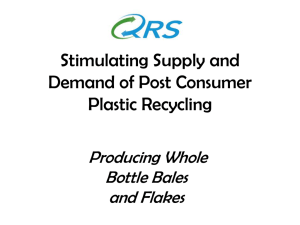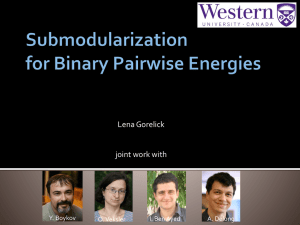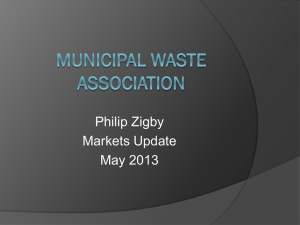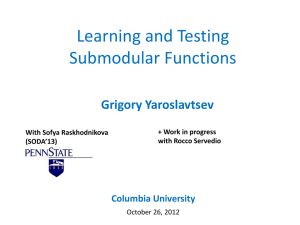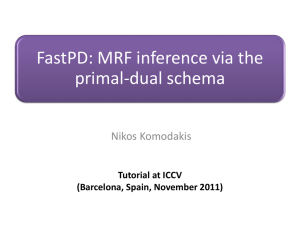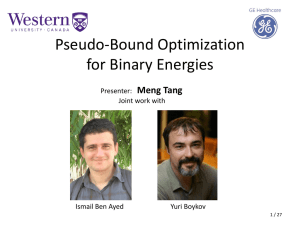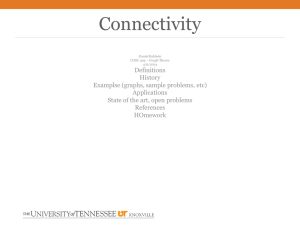Graph cuts for maximum a posteriori inference with Markov random
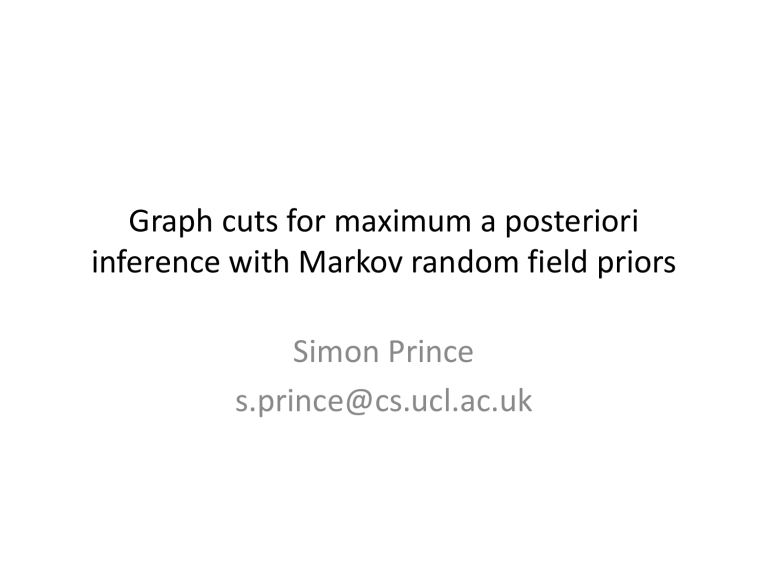
Graph cuts for maximum a posteriori inference with Markov random field priors
Simon Prince s.prince@cs.ucl.ac.uk
Plan of Talk
• Denoising problem
• Markov random fields (MRFs)
• Max-flow / min-cut
• Binary MRFs (exact solution)
• Multi-label MRFs – submodular (exact solution)
• Multi-label MRFs - non-submodular (approximate)
Binary Denoising
Before After
Image represented as binary discrete variables. Some proportion of pixels randomly changed polarity.
Multi-label Denoising
Before After
Image represented as discrete variables representing intensity. Some proportion of pixels randomly changed according to a uniform distribution.
Denoising Task
Observed Data Uncorrupted Image
Bayes’ rule:
Denoising
Likelihoods:
Prior: Markov random field (smoothness)
MAP Inference: Graph cuts
Many other vision tasks have this structure (stereo, segmentation etc.)
Plan of Talk
• Denoising problem
• Markov random fields (MRFs)
• Max-flow / min-cut
• Binary MRFs –submodular (exact solution)
• Multi-label MRFs – submodular (exact solution)
• Multi-label MRFs - non-submodular (approximate)
Undirected Models
• MRF is an example of an undirected model
• Product of positive potential functions
• Z is a normalizing constant
• Z referred to as “partition function”
Alternate Formulation
• Product of positive potential functions
• or product of exponential costs where
MRF Example
• Consider a product of functions over neighbours
• In this model a variable is conditionally independent of all the others given its neighbours
• For example
• So connections in graphical model (top) tell us about independence relations
Proof of Markov Property
Using conditional probability relation
(only depends on neighbours)
MRF Example
Consider the case where variables are binary, so functions return 4 different values depending on the combination of neighbours. Let’s choose
MRF Definition
Hammersley Clifford Theorem
Any distribution that obeys the Markov property can be written in the form
Where the c terms are maximal cliques
Cliques = subsets of variables that all connect to each other.
Maximal = cannot add any more variables and still be a clique
Original image, y
Denoising with MRFs
MRF Prior (pairwise cliques)
Likelihoods
Observed image, x
Inference via Bayes’ rule:
MAP Inference
Unary terms
(compatability of data with label y)
Pairwise terms
(compatability of neighboring labels)
Graph Cuts Overview
Graph cuts used to optimise this cost function:
Unary terms
(compatability of data with label y)
Three main cases:
Pairwise terms
(compatability of neighboring labels)
Graph Cuts Overview
Graph cuts used to optimise this cost function:
Unary terms
(compatability of data with label y)
Pairwise terms
(compatability of neighboring labels)
Approach:
Convert minimization into the form of a standard CS problem,
MAXIMUM FLOW or MINIMUM CUT ON A GRAPH
Low order polynomial methods for solving this problem are known
Plan of Talk
• Denoising problem
• Markov random fields (MRFs)
• Max-flow / min-cut
• Binary MRFs - submodular (exact solution)
• Multi-label MRFs – submodular (exact solution)
• Multi-label MRFs - non-submodular (approximate)
Max-Flow Problem
Goal:
To push as much ‘flow’ as possible through the directed graph from the source to the sink.
Cannot exceed the (non-negative) capacities c ij associated with each edge.
Saturated Edges
When we are pushing the maximum amount of flow:
• There must be at least one saturated edge on any path from source to sink
(otherwise we could push more flow)
• The set of saturated edges hence separate the source and sink
Min Cut
• Define a cut on the graph as a set of edges that separate the source and sink.
• Cost of cut = total capacity of these edges
• Edges that saturate in the maximum flow solution form the minimum cost cut
• Can talk interchangeably about max-flow or min-cut
Augmenting Paths
Two numbers represent: current flow / total capacity
Augmenting Paths
Choose any route from source to sink with spare capacity and push as much flow as you can. One edge (here 6-t) will saturate.
Augmenting Paths
Choose another route, respecting remaining capacity. This time edge 5-6 saturates.
Augmenting Paths
A third route. Edge 1-4 saturates
Augmenting Paths
A fourth route. Edge 2-5 saturates
Augmenting Paths
A fifth route. Edge 2-4 saturates
Augmenting Paths
There is now no further route from source to sink – there is a saturated edge along every possible route (highlighted arrows)
Augmenting Paths
The saturated edges separate the source from the sink and form the min-cut solution.
Nodes either connect to the source or connect to the sink.
Plan of Talk
• Denoising problem
• Markov random fields (MRFs)
• Max-flow / min-cut
• Binary MRFs – submodular (exact solution)
• Multi-label MRFs – submodular (exact solution)
• Multi-label MRFs - non-submodular (approximate)
Graph Cuts: Binary MRF
Graph cuts used to optimise this cost function:
Unary terms
(compatability of data with label y)
Pairwise terms
(compatability of neighboring labels)
First work with binary case (i.e. True label y is 0 or 1)
Constrain pairwise costs so that they are “zero-diagonal”
Graph Construction
• One node per pixel (here a 3x3 image)
• Edge from source to every pixel node
• Edge from every pixel node to sink
• Reciprocal edges between neighbours
Note that in the minimum cut
EITHER the edge connecting to the source will be cut, OR the edge connecting to the sink, but
NOT BOTH (unnecessary).
Which determines whether we give that pixel label 1 or label 0.
Now a 1 to 1 mapping between possible labelling and possible minimum cuts
Graph Construction
Now add capacities so that minimum cut, minimizes our cost function
Unary costs U(0), U(1) attached to links to source and sink.
• Either one or the other is paid.
Pairwise costs between pixel nodes as shown.
• Why? Easiest to understand with some worked examples.
Example 1
Example 2
Example 3
Graph Cuts: Binary MRF
Graph cuts used to optimise this cost function:
Unary terms
(compatability of data with label y)
Pairwise terms
(compatability of neighboring labels)
Summary of approach
• Associate each possible solution with a minimum cut on a graph
• Set capacities on graph, so cost of cut matches the cost function
• Use augmenting paths to find minimum cut
• This minimizes the cost function and finds the MAP solution
General Pairwise costs
Modify graph to
• Add P(0,0) to edge s-b
• Implies that solutions 0,0 and
1,0 also pay this cost
• Subtract P(0,0) from edge b-a
• Solution 1,0 has this cost removed again
Similar approach for P(1,1)
Reparameterization
The max-flow / min-cut algorithms require that all of the capacities are non-negative.
However, because we have a subtraction on edge a-b we cannot guarantee that this will be the case, even if all the original unary and pairwise costs were positive.
The solution to this problem is reparamaterization: find new graph where costs (capacities) are different but choice of minimum solution is the same (usually just by adding a constant to each solution)
Reparameterization 1
The minimum cut chooses the same links in these two graphs
Reparameterization 2
The minimum cut chooses the same links in these two graphs
Submodularity
Subtract constant b
Add constant, b
Adding together implies
Submodularity
If this condition is obeyed, it is said that the problem is “submodular” and it can be solved in polynomial time.
If it is not obeyed then the problem is NP hard.
Usually it is not a problem as we tend to favour smooth solutions.
Original
Denoising Results
Pairwise costs increasing
Pairwise costs increasing
Plan of Talk
• Denoising problem
• Markov random fields (MRFs)
• Max-flow / min-cut
• Binary MRFs – submodular (exact solution)
• Multi-label MRFs – submodular (exact solution)
• Multi-label MRFs - non-submodular (approximate)
Multiple Labels
Construction for two pixels
(a and b) and four labels
(1,2,3,4)
There are 5 nodes for each pixel and 4 edges between them have unary costs for the 4 labels.
One of these edges must be cut in the min-cut solution and the choice will determine which label we assign.
Constraint Edges
The edges with infinite capacity pointing upwards are called constraint edges.
They prevent solutions that cut the chain of edges associated with a pixel more than once (and hence given an ambiguous labelling)
Multiple Labels
Inter-pixel edges have costs defined as:
Superfluous terms :
For all i,j where K is number of labels
Example Cuts
Must cut links from before cut on pixel a to after cut on pixel b.
Pairwise Costs
Must cut links from before cut on pixel a to after cut on pixel b.
Costs were carefully chosen so that sum of these links gives appropriate pairwise term.
If pixel a takes label I and pixel b takes label J
Reparameterization
Submodularity
We require the remaining inter-pixel links to be positive so that or
By mathematical induction we can get the more general result
Submodularity
If not submodular then the problem is NP hard.
Convex vs. non-convex costs
Quadratic
• Convex
• Submodular
Truncated Quadratic
• Not Convex
• Not Submodular
Potts Model
• Not Convex
• Not Submodular
What is wrong with convex costs?
Observed noisy image Denoised result
• Pay lower price for many small changes than one large one
• Result: blurring at large changes in intensity
Plan of Talk
• Denoising problem
• Markov random fields (MRFs)
• Max-flow / min-cut
• Binary MRFs - submodular (exact solution)
• Multi-label MRFs – submodular (exact solution)
• Multi-label MRFs - non-submodular (approximate)
Alpha Expansion Algorithm
• break multilabel problem into a series of binary problems
• at each iteration, pick label a and expand (retain original or change to a
)
Initial labelling
Iteration 1
(orange)
Iteration 2
(yellow)
Iteration 3
(red)
Alpha Expansion Ideas
• For every iteration
– For every label
– Expand label using optimal graph cut solution
Co-ordinate descent in label space.
Each step optimal, but overall global maximum not guaranteed
Proved to be within a factor of 2 of global optimum.
Requires that pairwise costs form a metric:
Alpha Expansion Construction
Binary graph cut – either cut link to source
(assigned to a
) or to sink (retain current label)
Unary costs attached to links between source, sink and pixel nodes appropriately.
Alpha Expansion Construction
Graph is dynamic. Structure of inter-pixel links depends on a and the choice of labels.
There are four cases.
Alpha Expansion Construction
Case 1:
Adjacent pixels both have label a already.
Pairwise cost is zero – no need for extra edges.
Alpha Expansion Construction
Case 2: Adjacent pixels are a,b
.
Result either
• a,a
(no cost and no new edge).
• a,b
(P( a,b
), add new edge).
Alpha Expansion Construction
Case 3: Adjacent pixels are b,b
. Result either
• b,b
(no cost and no new edge).
• a,b
(P( a,b
), add new edge).
• b,a
(P( b,a
), add new edge).
Alpha Expansion Construction
Case 4: Adjacent pixels are b,g
. Result either
• b,g
(P( b,g
), add new edge).
• a,g
(P( a,g
), add new edge).
• b,a
(P( b,a
), add new edge).
• a,a
(no cost and no new edge).
Example Cut 1
Example Cut 1
Important!
Example Cut 2
Example Cut 3
Denoising
Results
Conclusions
• Graph cuts help you find the MAP solution in models with pairwise MRF priors (also CRFs!)
– Exact solution in binary case if submodular
– Exact solution in multi-label case if submodular
– Approximate solution in multi-label case if a metric
Contact me if you want slides or notes s.prince@cs.ucl.ac.uk

